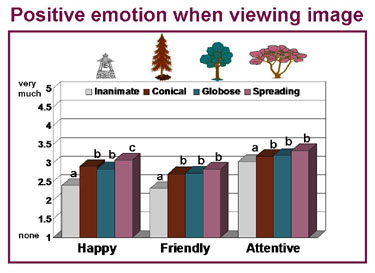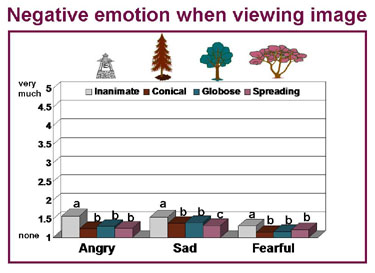Human Well-Being Promoted By Trees, Especially Those
With Preferred Forms
 Introduction
Introduction
People respond psychologically and physiologically to
urban and natural landscapes. Natural scenes elicit
greater calming responses than urban scenes. Viewing trees
in urban landscapes has been associated with improved
health. Different components of nature might promote
different human responses. People respond differently to
trees than to other elements in nature. People also prefer
particular tree forms, such as the low, spreading form of
savanna trees. The objectives of this research were to
compare people's responses to urban scenes containing
trees of different forms or inanimate objects.
Methods
Subjects' psychological and physiological states were
monitored while viewing individual computer-enhanced
slides of urban scenes with inanimate objects or
conical, globose, or spreading tree forms. Emotional
states were measured with a self-report survey. Blood
pressure and skin temperature were measured. Aesthetic
preference for each scene being viewed also was
evaluated.
Results
People reported more positive emotions, such as
friendliness, and fewer negative emotions, such as
sadness, when looking at urban scenes with trees than
when looking at the same scenes containing inanimate
objects. In some cases, the positive emotions reported
were magnified when viewing the spreading tree. Scenes
with inanimate objects were rated the least attractive,
while those with the spreading trees were rated the most
attractive. There were no significant differences in
blood pressure or skin temperature. However, trends were
similar to those for emotional responses. People tended
to be more relaxed when looking at scenes with trees
than those with inanimate objects, and the response was
accentuated with the spreading tree form.
 
Conclusions
People responded more positively to trees with conical,
globose, or spreading forms in urban settings than to
the same settings with inanimate objects. These results
support the importance of using trees of any form to
enhance urban environments. Positive responses were
intensified for trees with spreading forms. Spreading
trees may be important in areas, such as healthcare
facilities, where people are confined for extended
periods.
This research was partially supported by the Idaho
Department of Lands.
Full study reported
in:
Lohr, V.I. and C.H. Pearson-Mims. 2006. Responses
to scenes with spreading, rounded, and conical tree
forms.
Environment & Behavior 38(5):667-688. Abstract
|
|
